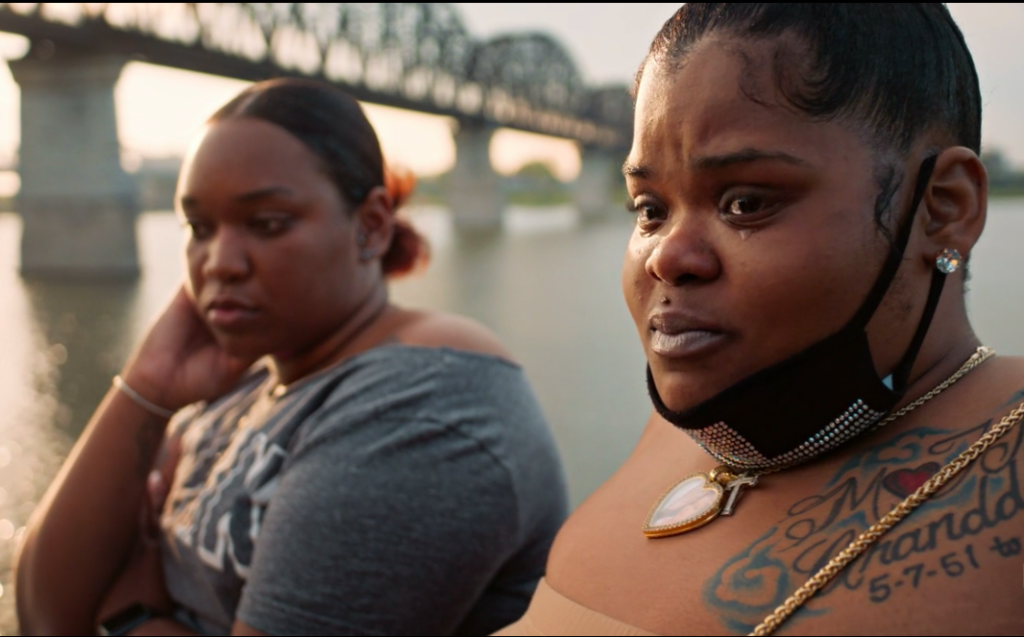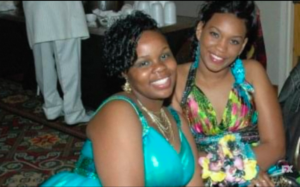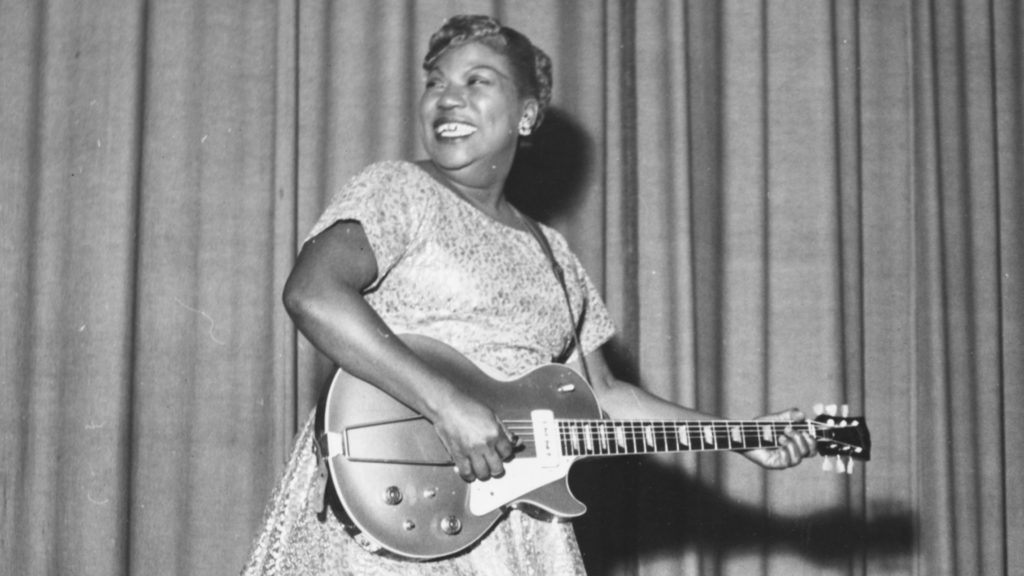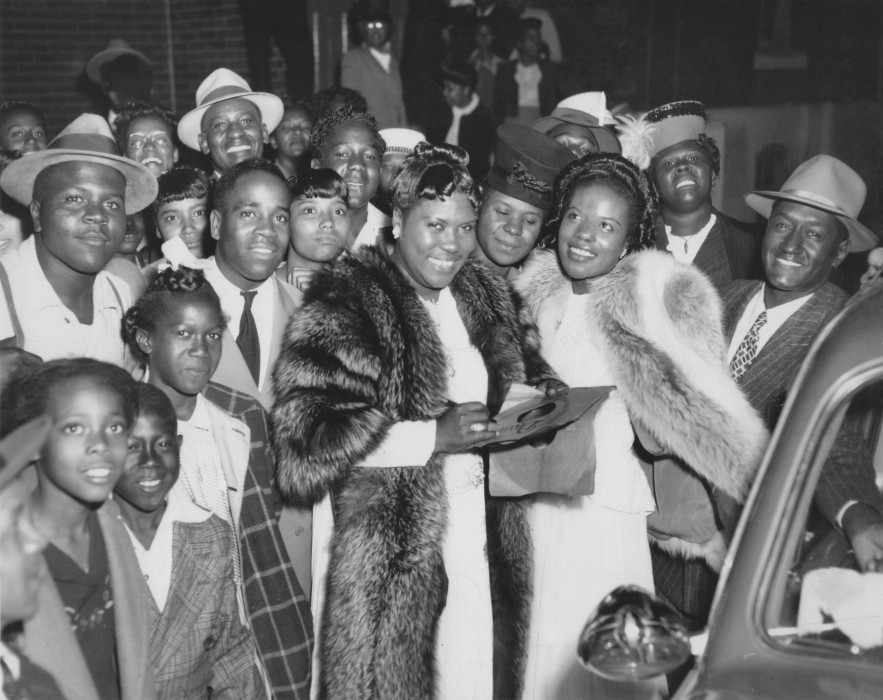What Breonna Taylor and Sister Rosetta Tharpe Taught Me About Black Women and Friendship
In a world that constantly presents narratives of our degradation, Black women’s intimate interpersonal ties paint a different image

Two of Breonna Taylor’s friends featured in “The New York Times Presents: The Killing of Breonna Taylor”
Last month I finally braved the widely promoted documentary “The New York Times Presents: The Killing of Breonna Taylor.” Having recently binged popular 1990s Black sitcom A Different World, Hulu’s over-eager streaming algorithm had me in its cross-hairs. But as a dark-skinned southern Black woman just six weeks Breonna’s senior, these consistent reminders of her state-sanctioned execution affected me in complex, yet exceedingly painful ways. It is probably safe to say that Hulu’s marketing division did not consider that these promotions would serve only as a reminder of my mortality. Somehow still letting my curiosity best my judgement, I scrolled back up my feed, selected the special, and stilled myself for what would follow. I paused several times as my heart and tear ducts disrupted my ability to witness yet another rendering of the fatal event. But although difficult, I found myself looking forward to hearing the memories her loved ones recounted about her life.

Breonna Taylor with a close friend
When details of the investigation and her murder tested my endurance, the love and care expressed in the voices of Breonna’s sister-cousins and early childhood friends Elysia, Preonia, and Katrina lifted my spirits. As the sun dissolved into a Kentucky waterfront, Elysia described how Breonna’s inspirational personality helped convince her to follow her dreams. Another scene featured Preonia and Katrina talking about their upcoming girls’ trip plans to Biloxi, Mississippi’s Black Beach festival. Instagram videos filled with their dancing, jokes, and laughter provided brief respites in an otherwise emotionally taxing portrayal. They brought humanity and life into a somber environment. Their memorial to her was the articulation of a life that encompassed much more than its tragic end. Breonna’s girlfriends painted a picture of vibrancy, graciously allowing viewers to see more than the systemic injustices that resulted in her untimely death — to see an existence filled with beauty.
Long after the credits finished rolling, I remained in my now dark living room reflecting on the significance of Black women’s friendships. Their ability to restore, revive, and resurrect a humanity too often forgotten in illustrations of violent encounters touched something deep in me. As someone who often writes and thinks about Black women and intimacy, seeing Breonna Taylor’s friends describe their relationship with her forced me to confront the ways that I sometimes sterilize the intimate bonds that add color to Black women’s lives. So I reoriented my gaze, actively looking for ways to practice the same type of care in my work as Breonna’s friends demonstrated in their segments.
I am currently researching the experiences of Black women in Gospel music. Thinking about Breonna’s friendships, I now viewed the subjects of my research – Sister Rosetta Tharpe, Roxie Ann Moore, and Marie Knight – differently. Not as separate entities making individual contributions to Black women’s history, but as friends who survived life’s twists and turns by affirming humanity in one another. Revisiting the ways that Roxie and Marie tended to Rosetta’s body, spirit, and legacy following her death in 1973 helped me pull back the layers of mutual tenderness and affection that had now become so essential to honoring Black women’s vibrant, multifaceted existence. Breonna Taylor’s friends revived a humanity overlooked in many recent media depictions and legal proceedings. And in doing so they inspired me to take similar care with Sister Rosetta Tharpe by centering her friendships with other Black women in my reflections.
***
In the late 1930s, a former Pentecostal revival singer performed her first set at the Cotton Club, a New York City performance venue where Black people could take the stage, but not sit in the audience. In a long dress with guitar at the ready, sonic underpinnings of the blues wafted from her instrument as she accompanied herself to a mix of spiritual and secular songs. Having grown up in church environments where feelings and affect reigned supreme, she knew that the bounds between sacred and secular were fragile at best – that their limits could be crossed or transgressed with a simple guitar pick or strategically placed riff. With club dancers to the back of her and congregants to the front, the carefully cultivated skills and anointing of her Holiness-Pentecostal training transformed her voice and hands into sacred instruments in this allegedly profane space the likes of which neither church nor world would fully appreciate until decades later. This performer was Rosetta Tharpe (1915-1973).

Sister Rosetta Tharpe in 1957
Rosetta was one of gospel music’s first international superstars. She performed blues, jazz, and spirituals in various venues, both baffling those familiar with her revival roots and intriguing audiences unaccustomed to her performance of bluesy songs with spiritual overtones like “That’s All” and “Strange Things Happening Every Day.” While her talent was rarely contested, her peculiar position straddling various spaces rendered her a conundrum to many. Was she a gospel or blues singer? Shouldn’t she be in a church? What do we make of a Black woman with a guitar? Was she truly religious or was it all an act? She reached her peak in the 1950s, before her novelty wore off and the music market trended in other directions. Blues and folk revivals in the U.K. kept her busy until sickness brought her stateside indefinitely. Though a slowed pace resulted in financial insecurity near her life’s end, she is remembered fondly today as the Godmother of Rock and Roll.
Rosetta’s two closest friends, Roxie Moore and Marie Knight, were what Southerners refer to as Rosetta’s “people.” Rosetta leaned on these women and stowed her confidence in them; she trusted them with her secrets, desires, dreams, and fears. Roxie Ann Moore (1916-2012), who befriended Rosetta as a teenager, was prolific in her musical writing practice, composing for such legendary acts as the Dixie Hummingbirds and the Golden Gate Quartet. She also lifted her voice and pen to speak out against the unjust treatment of women and misappropriation of funds in Afro-Protestant churches. After Rosetta was moved by Marie Knight’s (1920-2009) performance at a Mahalia Jackson concert, she convinced the gifted vocalist and musician to join her on subsequent tours where they’d perform as a duo. While she and Rosetta stuck to hymns and spirituals in their collaborations, Marie later struck out in pursuit of an R&B career. At various points, each of these women was estranged from the Pentecostal religious spaces where their talents were first recognized and developed. They had in common the gendered and racialized consequences of their misunderstood musical and spiritual strivings.
Though separated by several generations, the relationships between Breonna, Elysia, Preonia, and Katrina and between Rosetta, Roxie, and Marie illustrate the powerful impact of friendship and intimacy among Black women. They were able to see in each other a luminance unrecognized by the world. Just as the memeification of Breonna Taylor by individuals, corporations, and governing bodies detracts from the fullness of her humanity, narratives that focus on Rosetta’s financial precarity and later invisibility in the historical record present only one meager facet of what was a truly magnificent life. I find, instead, that these friendships demonstrate an ethics of care by practicing memorial recovery, by which I mean repainting Black women’s lives in ways that accurately display their expressiveness and expansiveness with an empathy typically withheld from the world. When hollow depictions of legacies, bereft of animation, liveliness, and levity are offered as the sole evidence of our existence, it is our friendships that lift us up a little higher to a much deserved place of eternal reverence.
***
On October 15, 1973, Rosetta’s mourners processed towards North Philadelphia’s Bright Hope Baptist Church. While entering the sanctuary that fall, they turned to admire the ornate stained-glass window of a brown-skinned, brown-eyed Jesus with kinky hair dominating the far wall. A red cross frames him, its arms extending into royal blues, lavenders, burnt oranges, and teals. Upraised eyes would meet a wooden ceiling, its shape similar to that of a capsized ship. Horizontal beams spread across the vaulting look down on red velvet-lined pews. Church shoes sank into matching red carpet as parishioners walked down aisles to find their seats. Funeral programs collected in the vestibule and distributed by ushers throughout the service would list the order of those selected to participate in the ceremony. Rosetta’s loved ones would not be surprised to see both Marie and Roxie’s names included. Their significant roles were indicative of their close relationships with her as well as their individual talents.
In the contemplative vein of scholars Zora Neale Hurston and Saidiya Hartman, I imagine Marie prepared her songs in Bright Hope’s large fellowship hall or a choir room situated off the sanctuary. I visualize Roxie somewhere close by, reading and re-reading the eulogy she’d handwritten for her friend a few days prior. “Rosetta was a loving, kind, warm and generous person,” it begins, a testament to Rosetta’s lasting impact. Having attempted several times to convince Rosetta to slow down and pay closer attention to her health in those final years, Rosetta’s husband, Russell Morrison, thwarted Roxie’s attempts to intervene. Roxie recalls Russell saying, “you take care of Roxie, I’ll take care of Rosetta!” on one occasion when she called to check on her friend. While prevented from looking after Rosetta’s body in life, Roxie’s eulogy tended to Rosetta’s everlasting presence in the hearts and minds of those gathered. For one reason or another, neither Marie nor Roxie completely trusted Rosetta’s husband with the funeral arrangements. Perceived by friends and loved ones as having mishandled Rosetta’s final days by filling her performance schedule despite serious illness, Marie and Roxie rushed to Rosetta’s side upon news of her passing. “We lived our lives together. . . we shared with each other while she was alive. . . I only want[ed] to see her buried as the person she was,” Marie reflected.

Rosetta Tharpe and Marie Knight with fans in 1947
Similar to the testimonies of Breonna Taylor’s friends, Rosetta’s relationships with Marie and Roxie offer significant evidence of her life and creative expressiveness. I’m reminded of Toni Morrison’s words in Sula: “in the safe harbor of each other’s company they could afford to abandon the ways of other people and concentrate on their own perceptions of things.” With similar backgrounds as revivalists and evangelists in the Church of God in Christ, Rosetta saw herself reflected in Marie and Roxie. Their friendship was a “safe harbor” from the racist and sexist projections of the world. In death and life, Roxie and Marie were their sister’s keepers, keeping her confidences and shoring up her commemoration by historians and documentarians.
Marie sang Thomas Dorsey’s “Peace in the Valley” for the service, a beloved hymn Rosetta herself performed and recorded many times. After the funeral, Marie proceeded to Baker and Baker funeral home to fix Rosetta’s hair and makeup for burial. I imagine Marie taking her time with each brush and stroke. Wanting her friend to look like herself, to remember her one last time as the “person she was.” Normally the province of funeral attendants, Marie had asked to prepare the body herself. Rejected by church institutions that viewed her performance style as ungodly and an ever-evolving entertainment industry that failed to recognize the genius of her musical innovations until much later, there were precious few spaces that acknowledged Rosetta’s full essence. Marie’s decision to handle these final preparations was both a personal and political choice in a world that consistently branded Rosetta an outsider.
Roxie Moore’s position as eulogizer granted her the responsibility of presenting Rosetta’s life as a tale of hope and comfort, inspiring family and friends to continue on life’s journey. She had to acknowledge the hurt of those left behind, while assuring them of Rosetta’s eternal joy in the company of the God to whom she dedicated her life and career. “We are sure that she has found ‘Peace in the Valley,” said Roxie, alluding to Marie’s earlier musical selection. “Although she loved her husband dearly and desired to live because of him, she had to cross over to see her Lord, for all Jordan had to get back last Tuesday morning and let Rosetta cross over to see the man that she sang about in her Songs!” Roxie was responsible for assuring everyone that, though absent in the body, Rosetta’s soul was finally, peacefully at rest.
***
My attention to Rosetta, Roxie, and Marie’s interconnected lives is a direct result of the love and care I observed in Breonna Taylor’s childhood friends. As the symphony of public outrage crescendoed in response to Breonna’s murder and the subsequent coverups that followed, I turned inward as a means of survival. I don’t mean inward to suggest an internalized emotional response to traumatic situations. But inward to Black girl friendships, which I trusted to water my weary soul, a response to repeated emotional assaults. Instead of focusing on the external harm and trauma dealt to Black women by virtue of intersecting class, gender, racial, and sexual oppressions, I turned inward to the worlds Black women create for themselves, together.
In a country that sees the murders of Black women as forgettable, our abuse as justifiable, and our cultural output as freely appropriable — in a world in which we are too often, too quickly cast aside — I’ve found peace in meditating on Black women’s friendships. I’ve found refuge in reflecting on our love for one another and in the words of those who describe sacred commitments to our interconnectivity. In Toni Morrison’s “convent,” Saidiya Hartman’s “chorus,” Ntozake Shange’s collective, and Alice Walker’s garden. In my mother’s daily telephone calls, my sister Edlyn’s laughter, and my aunties’ recipes. A peace that surpasses all understanding, which replaces the chill of hopelessness with the warmth of possibility.
As I live through this time, the work I do has transformed. Instead of questioning the erasure of Black women from the historical record and the systems that profit from this unknowing, I search for the places that see Black women. I ask about the intimate bonds that sustain us in a world that constantly names our unworthiness. These bonds reflect our relations, and our survival. I ask: is there space for colored girls who no longer wish to beg our names said, but who prefer the recognition reflected in the love of other Black women — romantic, companionate, or otherwise?
I contemplate Black women and our love for one another and take seriously the ways that we care for each other. When state executions of Black women are met with silence and our activism in social movements go unacknowledged, this work aids in my revitalization. Pausing to meditate on when and where Black women find friendship, intimacy, and care, given our paradoxical existence of hyper-(in)visibility, is life-affirming. In a world that constantly presents narratives of our degradation, Black women’s intimate interpersonal ties paint a different image.
I don’t take for granted that the connection between these women is indicative of all Black women’s ability to garner safe and healthy relationships. To do so would be disingenuous and irresponsible. But I do choose to lean into tender moments, like when Roxie and Rosetta found a New York diner late in the evening following a performance and let the sun beat them home; like the secrets exchanged as Rosetta protected her ears from Marie’s hot comb; like in the moments following Rosetta’s death when Marie and Roxie saw after her one last time. In these moments, I see devotion that wasn’t begged. A love never stamped out. An unwavering connection. How they found “relief in each other’s personality” and “in each other’s eyes the intimacy they were looking for . . .”
Until recently, Rosetta’s grave was difficult to locate. It was left unmarked after her burial in Philadelphia’s Northwood Cemetery in 1973, the same year Alice Walker would search for Zora Neale Hurston, finding her grave in a similar condition. Rosetta’s, however, would remain barren for another 35 years. Decades later, Rosetta’s name and contributions have been recovered and celebrated by musicians, scholars, and fans alike. Now there are books about her, she is a Rock and Roll Hall of Fame inductee, and her life has inspired several artistic projects. But even through all the posthumous international recognition, the epitaph on her recently identified grave is a selection from Roxie’s eulogy: “She would sing until you cried and then she would sing until you danced for joy. She helped to keep the saints alive and the saints rejoicing.” In the bonds of Rosetta, Roxie, and Marie, as well as Breonna, Preonia, Elysia, and Katrina, I find hope for a future where Black women are seen, heard, and celebrated in the complete essence of our beings. In our flaws, our genius, our full humanity. Where we may lift our hands, collectively rejoicing in the possibilities of a more peaceful reality.
Ambre Dromgoole is a Ph.D. Candidate in the combined program in African American Studies and Religious Studies at Yale University and a Sacred Writes/Revealer Writing Fellow. Her dissertation is tentatively titled “There’s a Heaven Somewhere’: Itinerancy, Intimacy, and Performance in the Lives of Gospel Blues Women, 1915-1983.”
***
This article was made possible in part with support from Sacred Writes, a Henry Luce Foundation-funded project hosted by Northeastern University that promotes public scholarship on religion.